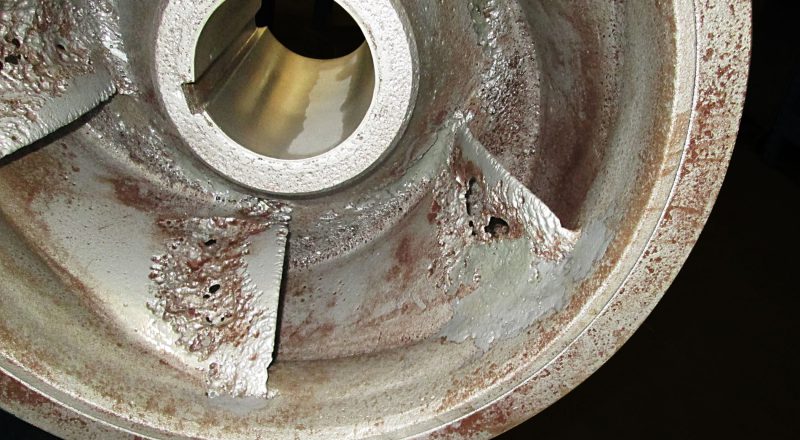If we want to answer the question of what is pump cavitation, we can say that this phenomenon is the evaporation of liquid in the pump at low pressures. It happens because there is not sufficient pressure at the pump suction end (Net Positive Suction Head Available (NPSHA)). When cavitation occurs, air bubbles are produced at low pressure.
As the liquid moves from the suction side to the delivery side of the impeller, the bubbles collapse. This makes a shockwave hitting the impeller, leading to vibration and mechanical damage, and eventually failure of the pump at some stages.
Cavitation can cause serious negative impacts on the pump operation and lifetime. This phenomenon can affect many features of a pump, but the pump impeller is often the most severely impacted part. A relatively new manufactured impeller impacted by cavitation typically appears to have been in use for years; the impeller may be eroded and be damaged beyond repair.
Definition of Pump Cavitation
Every liquid vaporizes at a certain temperature and pressure called the vapor pressure. For example, water evaporates at standard atmospheric pressure and the temperature of 100°C. Now, if the pressure is decreased to 0.02 atm, the water evaporates at 20°C. When the liquid flows through the pump impeller, vapor bubbles are formed if the liquid pressure reaches a level lower than the vapor pressure at the working temperature.
The flow transfers these bubbles to the other sections of the impeller with higher pressures. If the pressure in the new region is high enough, the vapor bubbles will collapse. Thus, cavities are created in the liquid, causing other liquid particles to stray from their primary paths and strike other surfaces such as impeller blades at a very high speed. Depending on the severity of the impact on these surfaces, erosion takes place on the blades, and the surface becomes porous. This event is called cavitation.
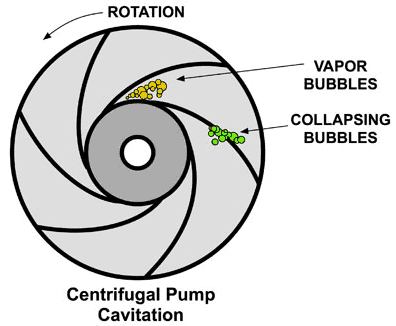
Causes of Pump Cavitation
Pumps are designed to operate at full water flow, but in some cases, a flooded inlet is not sufficient to keep the pressure required to prevent the cavitation phenomenon. The suction side of the pump (inlet) is the lowest pressure point in a pump. For positive displacement pumps, the lowest pressure occurs before rotor meshing; however, the lowest pressure point is near the impeller eye in centrifugal pumps.
Cavitation occurrence is possible in all pump types, and because its basics are the same, we will discuss centrifugal pumps. The fluid is drawn into the impeller from the eye impeller. The rotation of the impeller acts on the fluid. If the pressure acting on the liquid is too low (i.e., Net Positive Suction Head Available is too low), bubbles will be formed. As the liquid accelerates due to the impeller rotation, the pressure rises, and the bubbles collapse.
At atmospheric pressure conditions, liquids have a predictable vapor pressure. As the pressure inside the pump drops under the vapor pressure of the liquid, bubbles form. When they reach zones where the pressure is more than that of vapor pressure, they collapse. The processes of formation and collapse are both fast and strong.
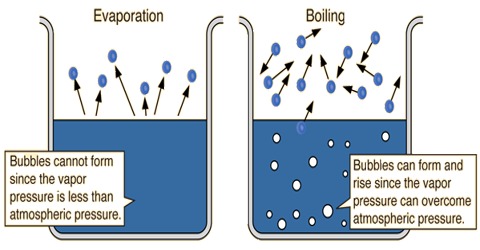
The following conditions may cause cavitation inside the pump.
Flow Disruption at Pump Inlet
Flow disruptions may have different causes, such as system design and component degradation. The main reasons are as follows:
- Very long inlet piping
- very high fluid viscosity
- Clogged inlet
- Clogged filters and strainers
- Limited or collapsed inlet hoses
- Poorly specified pump
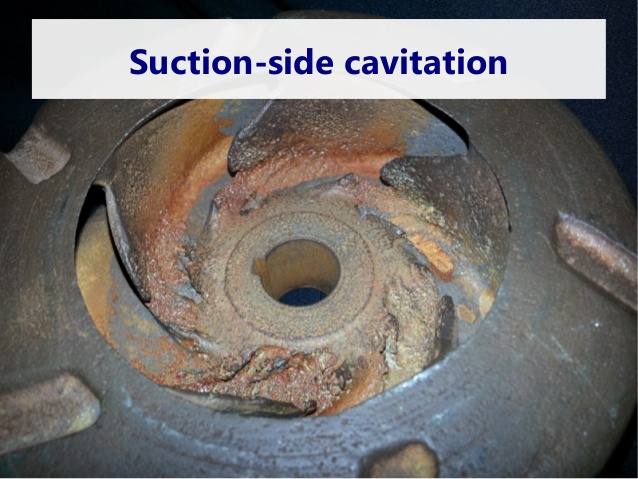
Discharge Cavitation
A portion of the fluid circulates inside the pump at very high discharge pressure instead of discharging. The fluid trapped between the impeller and the casing at a very high velocity causes a pressure drop. Thus the same conditions as for suction cavitation are created.
Common causes of discharge cavitation are:
- Clogged filters
- Pipe blockages
- Poor piping design
Cause and Effects of Pump Cavitation
The reasons for cavitation in pumps and the types of cavitation created can be briefly listed as follows:
- If NPHSA falls below NPSHR, it leads to cavitation due to the decreased pressure. It means that the condition for avoiding cavitation is:
NPSH_R>NPSH_A
- Restricted discharge flow results in cavitation due to low flow conditions.
- Leakage in packing, piping, O-rings, and seals creates cavitation due to air aspiration.
- An undesired consequence of restricted suction flow such as those in sharp elbows, clogged filters, or strainers is cavitation due to turbulence.
Sings of Pump Cavitation
The most noticeable signs of cavitation are noise and vibration. When bubbles of vapor collapse, they can make a severe sound like gravel rattling on the pump parts. In addition to noise, there may be unusual vibrations that are not experienced when running the pump and its equipment in normal conditions.
In centrifugal pumps, the discharge pressure can be reduced from that commonly determined by the pump manufacturer. In positive displacement pumps, cavitation reduces the flow instead of the head or pressure since vapor bubbles remove fluid from the pumping chamber, decreasing its capacity.
Power consumption may be affected by the unpredictable conditions due to the cavitation. It may vary and be higher to achieve the same production capacity. Also, in severe cases, when cavitation damages the pump components, you may see debris in the discharged liquid from the parts of the pump, such as seals and bearings.
The effects of long-term cavitation are evident on the pump impeller and other parts. In short, typical indications of cavitation are as follows:
- Noise
- Vibration
- Impeller erosion
- Seal or bearing failure
- Higher than normal power consumption
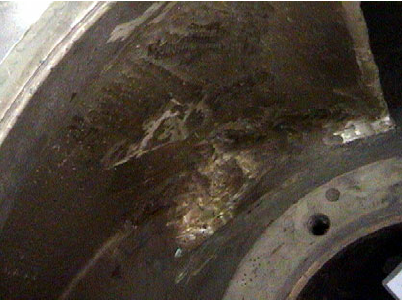
Effects of Pump Cavitation
If we want to enumerate the effects of cavitation, we can mention the following:
- The surface of a passage is damaged because of shock waves generated by collapsing of bubbles and cavitation creates cavities on metallic surfaces.
- Cyclic stress on the boundary surface results in the fatigue of material.
- Extensive vibration and loud noise are created by sudden bubbles collapsing.
- Cavitation generally has a negative effect on the efficiency of pumps due to restriction of the flow.
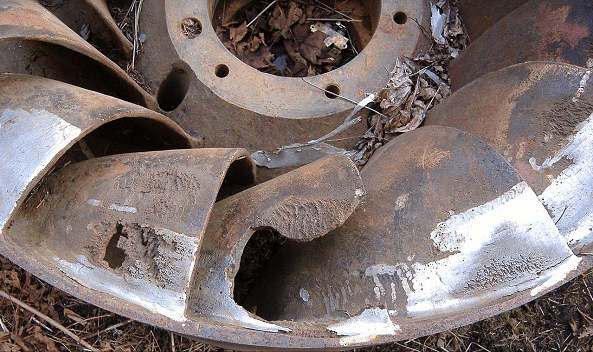
How to Prevent Pump Cavitation
First, we have to identify the cause of the pressure drop. In many cases getting the pump closer to the source of the liquid and eliminating as many bends and valves as possible will solve the problem because each component makes further pressure drop. When the suction lift is too high to keep the pressure, we can bring the pump closer to the liquid source or the fluid source near the pump.
Enlargement of suction lines can also be helpful. In some cases, a blockage happens in the piping or hoses near the pump. Clear the blockages to fix the problem. Remove debris from suction lines. Do not blow the debris back toward the liquid source as re-blockage is possible.
Here we discuss the most effective ways to prevent pump cavitation.
Pump Selection
The most effective way to prevent cavitation is to choose the right pump. The risk of cavitation increases as the pump head drops or as capacity increases. Therefore, selecting the best pump to maintain the NPSHA more than NPSHR is the best approach.
NPHS at the inlet is dependent on atmospheric pressure, friction losses through the suction piping, and flow velocity. As a general rule, the pressure at the pump inlet is 10% greater than the pump NPSHR. For example, if NPSHR is 5 meters, NPSHA should be at least 5.5 meters.
The Ways to Increase Net Positive Suction Head Available
- Elevate and maintain tank fluid level
- Raise supply tank
- Reduce piping losses from too many joints or very small diameters
- Replace the damaged components
- Remove solids from inside of pipes
- Clear the suction strainer
- Replace the corroded pipe
Consideration of Discharge Cavitation
Discharge cavitation happens when the pressure at the end of the pump discharge is too high. High discharge pressure limits the amount of fluid leaving the pump and causes high-velocity fluid recirculation between the pump impeller and housing, resulting in cavitation.
Pump Maintenance
Regular maintenance increases pump life and stable performance. After selecting the best pump suitable for the application, regular pump maintenance is the best way to prevent cavitation.
- Check regularly the filters and strainers. Dirty or clogged filters and strainers create pressure buildup within the pump. Proper maintenance ensures the correct performance of the pump system.
- Assess the overall design of the pump system. It includes the evaluation of the availability of the optimum flow rate through the pump.
- Evaluate the characteristic curves. Consider the pressure demands and then the pump data to check if it fits the purpose. From there, you determine if the pump is suitable for the needed flow rate.
- Check pressure measuring equipment.
- Look for cracks or damages to the pipes and other parts that may disrupt the system.
Installation Considerations
The proper installation aims to ensure that the net positive suction head available (NPSHA) will be greater than the net positive suction head required (NPSHR). The following four items need to be carefully assessed for this purpose.
Pump Location
Physical installation of the pump must be done in a way that the water flows into the pump inlet smoothly. The suction lines leading to the pump inlet must be sloped adequately so that the pump housing is flooded.
Pumps work most efficiently when the fluid moves in a smooth and laminar because turbulence, in general, reduces pump efficiency. So placing the pump as close as possible to the fluid source is recommended.
Moreover, positioning the pump at a point below the water level in the source from which it pumps uses the gravity force to maintain flooded suction in many cases prevents cavitation.
Suction Pipe Physical Characteristics
In general, you need 12 cm of straight pipe for each centimeter of pump suction diameter. To keep the flow laminar, a diameter of 5-10 of straight piping to the inlet is proper. Do not regard elbows, valves, or strainers within the final length of piping. An elbow connected directly to the pump flange draws fluid towards the outer curve of the elbow rather than directly into the eye of the impeller.
Also, the piping pattern must not cause strain on the casing of the pump.
Suction-side piping is usually one or two sizes greater than the pump inlet.
Larger pipework needs a reducer prior to the inlet and must be designed precisely to prevent turbulence and forming air pockets at the inlet.
In general, suction pipe velocities must be kept below two meters per second. Higher velocities may cause more friction and noise.
Suction Lift
Suction lift is the vertical span from the water source level to the pump inlet. This can exceed the energy requirements on pumps, and increase the turbulence, and decrease the NPSHA.
To solve the problem, it is recommended to install the pump under the water supply level and observe piping design standards.
Friction Loss
As a liquid passes through the pipe, friction between the internal surface of the pipe and the liquid causes turbulence. It slows the fluid motion and leads to a pressure drop. The parameters affecting the friction loss include pipe length, diameter, and flow rate.
Suitable piping arrangements help maintain constant velocity and prevent cavitation. Obstructions in piping designs affect the velocity of the flowing liquid and may cause cavitation due to pressure changes.
Pump Cavitation Types
We can divide different types of cavitation into five groups.
Vaporization
It is also known as classic cavitation and is the most common type of cavitation. It happens when a pump adds velocity to a liquid as it passes through the impeller eye. If the impeller is not working perfectly, a portion of the liquid may be boiled immediately (vaporized), creating tiny shock waves.
Turbulence
If some elements of the system, such as pipes, valves, filters, and elbows, are not suitable for the application of pumping, this can cause vortexes in the liquid and lead to the turbulence of the liquid and pressure differences. Therefore, the pressure differences may erode solid materials over time.
Vane Syndrome
This type of cavitation takes place when either the impeller diameter is too large or the housing coating is too thick. One or both of these create less space inside the housing. Then, the small amount of free space increases the velocity of the liquid, leading to lower pressure. Consequently, the liquid heats up, and cavitation bubbles form.
Internal Recirculation
In this case, the pump cannot be drained at the usual rate and the liquid is recirculated around the impeller. Thus, the liquid moves through low and high-pressure regions resulting in heat and high velocity. Again, vaporized bubbles form. The common reason for this is when a discharge valve is closed while the pump is running.
Air Aspiration Cavitation
In this type of pump cavitation, air can be sucked into the pump through broken valves or other weak regions such as joint rings. When the air enters the pump, it forms bubbles.
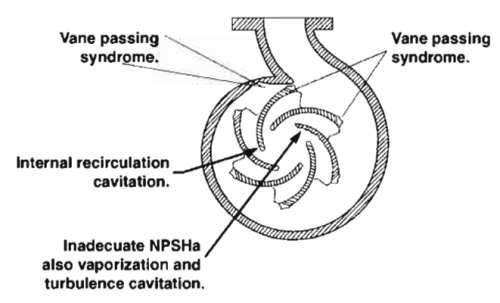
What Is NPSH?
To prevent cavitation, the fluid pressure has to be maintained over its vapor pressure at all points through the pump. Centrifugal pump designers specify a property called the Net Positive Suction Head Required (NPSHR) that recommends the minimum fluid inlet pressure. The documentation provided with the pump may contain diagrams displaying NPSHR variations versus flow changes.
In other words, NPSHR is defined as the pressure of the suction-side at which cavitation decreases the discharge pressure by 3%. At this pressure, the pump is already experiencing cavitation. As a result, it is important to establish a safety margin (about 0.5 to 1m) to consider this and other factors, including:
- Operating temperature of the pump
- Atmospheric pressure changes
- Friction losses occurring occasionally or gradually over the life of the system
In the design of the suction-side of the system, you have to ensure that it is greater than the NPSHR rating for the operating conditions provided by the manufacturer. It is called NPSH Available (NPSHA).
The net positive suction head available can be expressed:
NPSH_A=\left(\frac{p_i}{\rho g}+\frac{V^2_i}{2g}\right)-\frac{p_v}{\rho g}
The index i represents the inlet of the pump. Also, pv denotes the vapor pressure of the fluid. Applying the first law of thermodynamics on the control volume around the suction surface and the pump inlet leads to the following equation.
\frac{p_0}{\rho g}+z_0=\frac{p_i}{\rho g}+\frac{V^2_i}{2g}+z_i+h_f
Combining the above equation with the Bernoulli equation results in the following relation for calculating the net positive suction head available:
NPSH_A=\frac{p_0}{\rho g}-\frac{p_v}{\rho g}-\left(z_i-z_0\right)-h_f
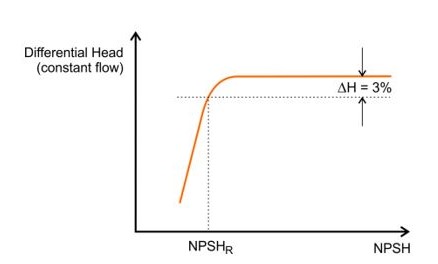
Mathematical Relation of NPSH with Cavitation
The NPSH is present in several other cavitation-related parameters. The suction head coefficient indicates a dimensionless measurement of NPSH:
C_{NPSH}=\frac{g.NPSH}{n^2D^2}
where n is the pump angular velocity (in rad/s), and D is the pump impeller diameter. Thoma’s cavitation number is expressed as:
\sigma =\frac{NPSH}{H}
H is the hydraulic head in meters.
FAQ
What Causes Cavitation in a Pump?
Cavitation happens when bubbles form in the fluid flow because the pressure drops below the vapor pressure. As the bubbles reach a location with higher pressures, they collapse and create small shockwaves that damage the components over time. Typical causes of suction cavitation include clogged filters, clogged pipe on the suction side, poor piping layout, pump running away from the design point of the pump, or conditions that cannot provide NPSH requirements. Also, discharge cavitation happens due to very high pressure at the pump discharge end.
What Does It Mean to Cavitate a Pump?
In the oil and gas industries, if NPSHA is smaller than NPSHR, the pump will cavitate. In the mining industry, some pumps have liquid under the pump, and the act of lifting the liquid creates a vacuum inside the pump.
In the mining industry, some pumps have liquid under the pump, and the act of lifting the liquid creates a vacuum inside the pump. Also, while launching a new pumping system, the pump may start to cavitate as the tank reaches a certain level well above the calculated minimum NPSHA. At a certain level, a vortex is forming at the liquid outlet. This allows the gas (not bubbles, but real gas) to enter the pump.
How Do You Fix Pump Cavitation?
The following recommendations are given to prevent cavitation due to vaporization:
- Fix the NPSHA greater than NPSHR (about 0.5 to 1m) or more for a safety margin
- Lower temperature
- Elevate the liquid level in the suction tank
- Change out pump type
- Reduce motor rotational speed
- Use impeller inducer
- Increase the diameter of the eye of the impeller
How Do You Know if a Pump Is Cavitating?
The most common ways for detecting cavitation in a pump are abnormal noise and vibration.
Buy Equipment or Ask for a Service
By using Linquip RFQ Service, you can expect to receive quotations from various suppliers across multiple industries and regions.
Click Here to Request a Quotation From Suppliers and Service Providers
Read More on Linquip

